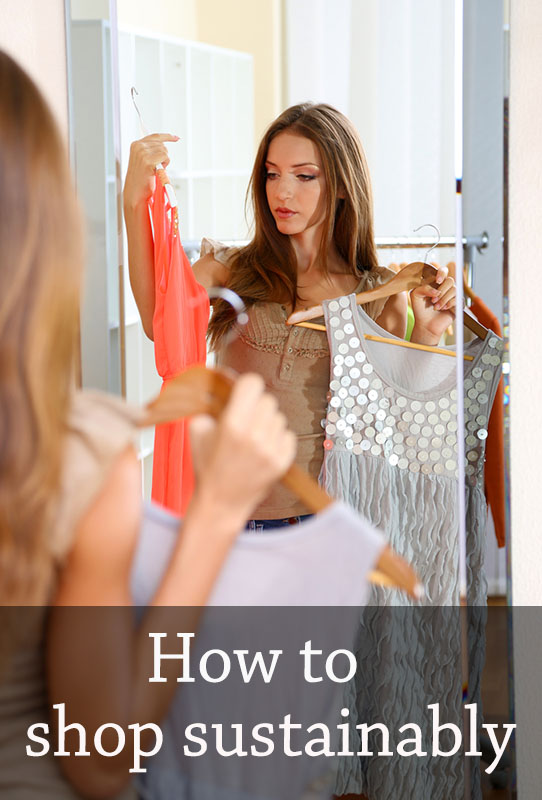Sustainable fashion can be qualified as such through a variety of different means; overall, it involves looking at the garment’s life cycle. Even then, it means different things to different people, since we all prioritize different facets of clothing manufacturing.
The goal of sustainable fashion is to bring environmentalism and social responsibility into the clothing manufacturing process. So if you wanted a more sustainable wardrobe, you would buy items that are vegan, fair-trade, organic, non-toxic, etc. And since some people prioritize different things (like, maybe you only really care that your clothes are animal-friendly, and aren’t so concerned with who made it), there are a lot of variations in how people perceive eco-friendly fashion.
Personally, I try to ensure that when I buy something, it includes some aspect of sustainability. I’m big on buying fair trade (not just in clothing, but all things!), but I’m also a huge animal lover, so I always shop vegan (this rule hasn’t made its way into my diet yet, but I’m working on it!). If I see an organic or locally-made version of something, I’m all over it!
If you’re just starting out building a sustainable wardrobe, it’s important to just do what you can- whatever is easiest! For me, that means buying secondhand. Whether it’s shopping at thrift or consignment stores, or doing clothing exchanges with friends, it’s a simple and great way to be more sustainable. Bonus: this is also a fantastic way to save your hard-earned cash!
So if you want a more sustainable wardrobe, read on! Here’s some of the more common facets of sustainability, and what they mean for you. This list is not all-inclusive, but it’s some of the more common aspects of sustainability that I’ve come across!
1. Made in the USA. Assuming you are a resident of the US, buying things that are made here (buying locally, in a sense) reduces the carbon footprint compared to an item made overseas that gets shipped all around as raw materials make their way to a factory and then eventually into a retail store. Also, because the US has stricter labor laws than other countries (like Bangladesh), you can be assured that the items you’re buying are at least someone socially responsible, as the workers were fairly compensated. Also, items made in the USA are typically better quality, and are more preferable at fashion trade shows for that reason.
2. Secondhand. Secondhand items are my go-to, and the lower price point is just a bonus. As I mentioned earlier, you could go either way with this. If you’re more adventurous, check out a thrift store. If you want quality designer items that are vetted for authenticity, check out a reputable consignment store. Can’t find one near you? Try Ebay! You can find a ton of gently-used designer items there. There are even apps now, like Twice or Threadflip (there are a bunch of others), that let you buy and sell gently used clothing and accessories. After all, the most eco-friendly item is the one that already exists!
3. Fair trade. Basically, fair trade items are items that are people-friendly! They’re usually made by skilled artisans in developing countries who are fairly compensated for their work. Companies that use fair trade practices usually have some commitment to social good, and will also work on helping those local communities in other ways. Through fair trade practices, higher prices are paid to the exporters, since they come from developing countries who need that income, and are going to developed countries who need those goods. So overall, fair trade promotes equality in trading partnerships between developed and developing countries. Good news all around!
4. Vegan/animal-friendly. These are items that would be PETA-approved. This aspect of sustainable fashion is more common with accessories and outerwear, since those are items that are normally made out of animal skin or fur. The only drawback is that a lot of vegan clothing items are made with plastics that aren’t always recycled, which can take a major toll on the environment. Also something to watch for- a lot of bigger brands (as in, brands that mass produce clothing and accessories) will use vegan materials as a more cost-effective measure compared to actual animal skin, so you may also be sacrificing quality if you purchase something that’s both vegan AND mass-produced.
5. Recycled. Recycled plastics are the most common, especially in accessories (see above!). There are quite a few brands out there now who see the value in using recycled plastics as a quality substitute for leather. Plastics are notoriously harsh on the environment (both in terms of their production and the waste they produce post-consumption), so recycled plastics are always the way to go! I also can’t talk about recycling and not mention Reformation, a really cool brand that re-invents vintage items for the modern shopper.
6. Organic. Like organic fruits and veggies, organic fabrics are made in accordance with organic agricultural standards. Meaning, the fabric is pesticide-free and herbicide-free. The cotton farming industry is one of the biggest water consumers, and organic cotton farming actually uses less water and has lower carbon emissions. Better yet, organic items are pretty easy to find. Even most fast-fashion retailers will have organic capsule collections (the stuff is still mass-produced, buy hey, using organic materials is a good start!).
7. Sustainably harvested. This is similar to the above, but what I’m trying to highlight in this one is items that are made from sustainable fibers. As in, clothes that don’t involve pillaging rainforests. In some areas of the world, rainforests are actually endangered because of fashion’s obsession with fibers like rayon, viscose, and modal, that are made almost exclusively from endangered tropical rainforests. What’s so enticing about these trees? The pulps are extracted to make the soft fabrics that are commonly used throughout the fashion industry.
8. Non-toxic. Some people have chemical sensitivities that make them really susceptible to irritation from toxic dyes and other fabric-enhancers like wrinkle-free, stain-resistance, or flame-retardant properties.Even if you don’t have one those sensitivities, it’s probably best to avoid toxic chemicals in your clothes! thankfully, a lot of brands who already make organic clothing see the value of non-toxic vegetable-based dyes, and use them frequently (because nobody likes poisoning themselves for fashion).
9. Custom ordered items. This involves buying items made-to-order, rather than something that’s been mass-produced. Some brands have found this to be a more sustainable business model anyways, and will advertise items on their websites (vice in a physical storefront), and will make only what’s ordered by their customers. Another positive aspect- shoppers can usually customize size, style, and fabric.
10. Giving back. Now, this one isn’t necessarily an aspect of sustainable fashion itself, but it’s another plus of the sustainable fashion industry that a lot of brands offer. Since most of these companies see the value in socially-responsible business practices, they also incorporate some aspect of giving back, whether it’s through direct cash donations (where a portion of the cost goes to a charity, for instance) or through donating in-kind (like donating one pair of glasses for every pair you buy).
[Photo of woman shopping from Shutterstock]


